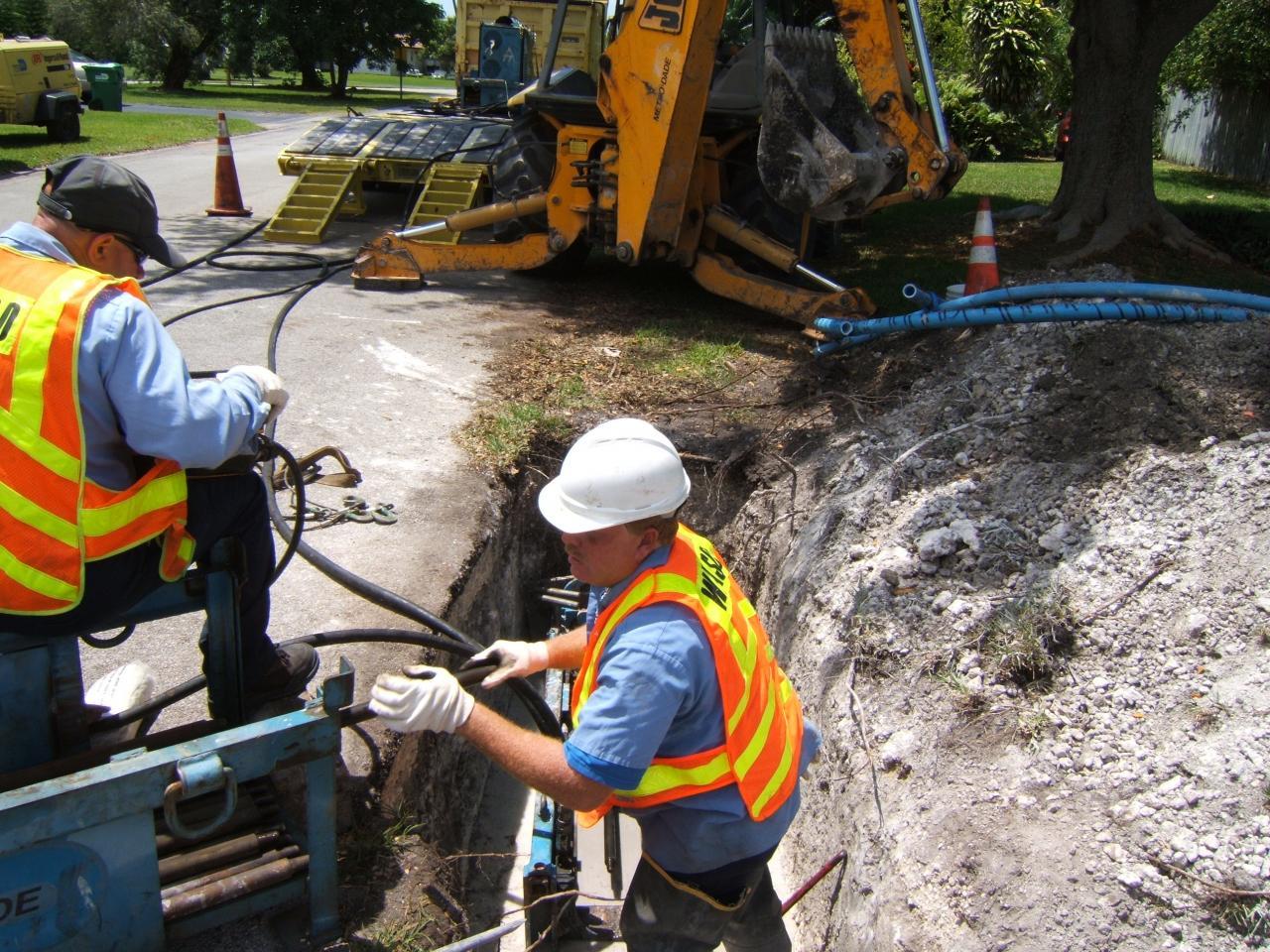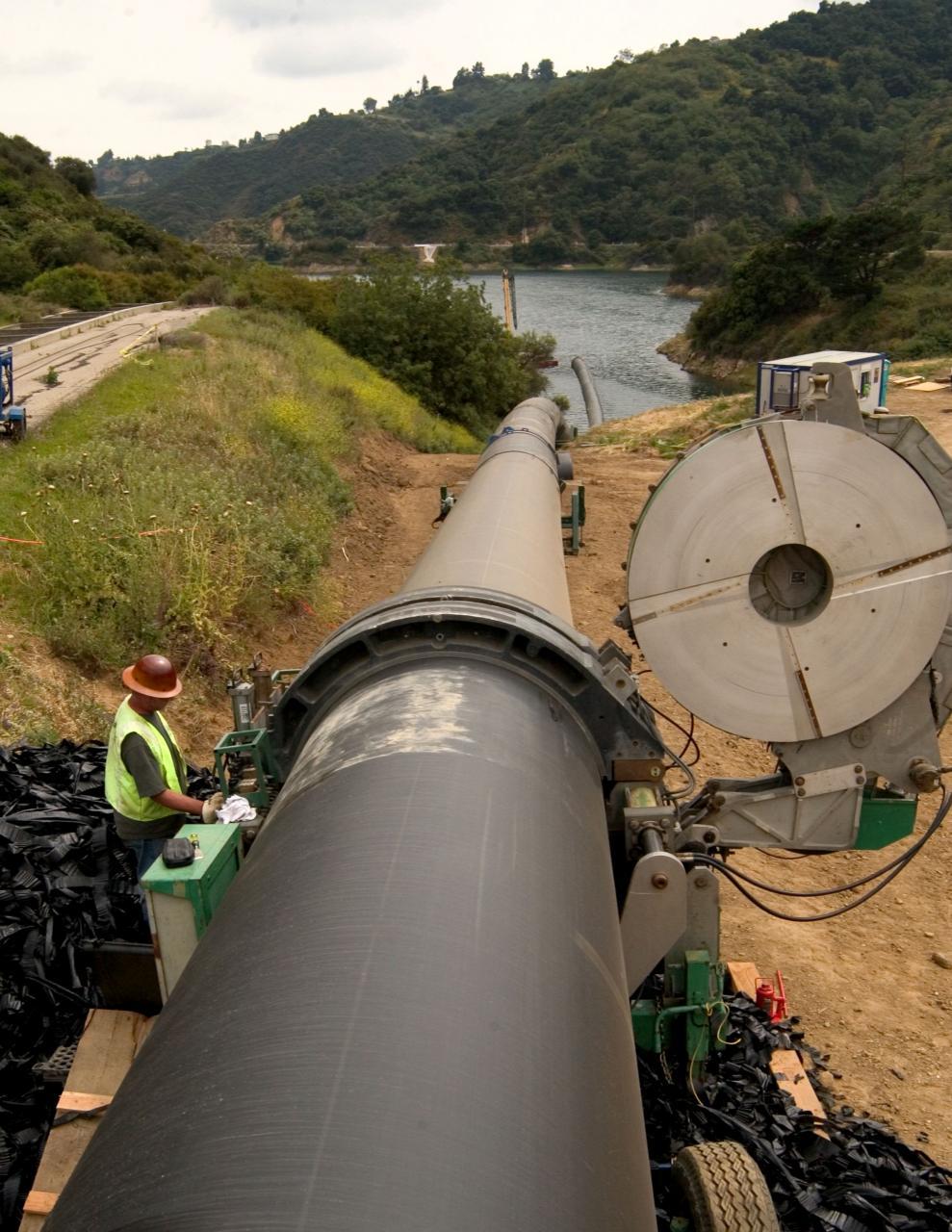May 20, 2016 Updated 5/20/2016
Email Print

Plastics Pipe Institute High density polyethylene pipe used at a water project in Florida.

Plastics Pipe Institute HDPE pipe being installed in a trenchless process in California.
As unpredictable spikes in lead continue to plague the water system in Flint, Mich., philanthropic pledges of some $ 125 million poured in just in recent weeks to help residents through the crisis.
Meanwhile, one donation worth millions of dollars that could help fix the lead-leaching pipes has been in limbo at Flint City Hall for three months and may never get serious consideration.
Back on Feb. 22, Walter Wang, the CEO of JM Eagle, the largest plastic pipe manufacturer in North America, told the Flint City Council his Los Angeles-based company would provide enough free pipe to replace all the residential and commercial lead service lines (LSLs) in the city of 99,000.
However, no action has been taken yet as Flint finalizes the bidding process to widen its scope of LSL replacement from 33 pilot houses that just got new copper lines to 500 households.
That’s because Flint is among the U.S. cities that does not allow for the specification of plastic pipe, according to Tony Radoszewski, president of the Plastics Pipe Institute, a trade association based in Dallas.
“Our members have been trying to sell to Flint for years and they can’t,” Radoszewski said in a telephone interview. “It’s not only the service lines but the water mains as well. So they’re using ductile iron in the water mains and copper in the service lines. And copper is not an inexpensive choice.”
Copper pipe is two to three times more expensive than polyethylene pipe, which is what JM Eagle offered Flint, Radoszewski said.
Of the 32,900 service connections, Flint’s website says more than 15,000 are “considered” LSLs and the estimated average price to replace each one is $ 4,000. That puts the total cost at $ 60 million or more.
Another research team put the number of LSLs at 4,300 but found 13,000 made of an unknown material that could be lead. The state has hired an engineering firm to do an inventory of the service lines connecting homes and businesses to the water mains at the street.
The uncertainty about the number of LSLs makes the value of JM Eagle’s offer hard to estimate, but it is surely substantial for a once affluent auto boomtown dogged by Rust Belt woes. Through the years, job losses led to an eroded tax base, then city debt, then emergency financial managers, then rust-colored water from a botched money-saving switch to the Flint River as a water source in 2014.
Poisoned water flowed from city taps for 18 months before a pediatrician sounded alarms about elevated lead levels in newborns and the water source eventually was changed back to Lake Huron. Lead is a neurotoxin that can cause permanent health effects, such as lower IQs, delayed development and behavioral problems.
“You’d think a municipality so devastated over the last 40 years would do everything they can to maximize their financial resources, and yet they are not doing it,” Radoszewski said. “Why is that?”
Beyond ‘plastophobia’

Plastics Pipe Institute Small HDPE water pipes going into place.
Some in the industry say there could be a bias against plastics to support the metal workers in Flint, where General Motors Co. is the largest employer. Or, maybe it’s a case of plastophobia about PE pipe, even though it has been tested and certified to meet water purification standards set by NSF International and is widely used elsewhere.
Radoszewski chalks the lack of follow-up on the JM Eagle offer to the “habituation factor” — a term he first heard at a conference for U.S. mayors in a discussion about what happens when municipal officials are faced with certain decisions, like choosing between a material that has made great advancements in the last 50 years and one used since ancient Egypt.
“You can demonstrate until you are blue in the face that you have a superior alternative system with a lower cost and a longer service life, and they are still reluctant to make the change,” Radoszewski said.
Other communities’ acceptance of PE has turned it into the No. 1 pipe material used in water systems in Europe and one that is gaining market share in the United States, where it competes against copper for service lines.
There are a lot of reasons public and private utilities are modernizing their water systems with plastic, Radoszewski said. He rattled off a list of benefits: PE pipe has a 100-year service life; never rusts or leaches lead; doesn’t leak because it is fused; and is as flexible as it is durable, which means cheaper trenchless installations are possible.
“You don’t tear up streets,” Radoszewski said. “You bore a hole on one end, pull the pipe through, and come up the other end. When you use trenchless installation techniques, you can save up to 40 percent of your installation cost.”
Another big plus, he added: Water in plastics systems do not have to be treated with corrosion-controlling chemicals. Radoszewski pointed to the federal lead and copper rule that sets monitoring and treatment parameters for lead, which can damage the brain, red blood cells and kidneys when it gets into drinking water; and copper, which can damage the liver and kidneys and cause intestinal distress.
“There’s all this complexity with traditional pipe materials and that’s what got Flint in trouble in the first place” Radoszewski said, referring to the city switching water sources from Lake Huron to the more caustic Flint River without adding anti-corrosion chemicals.
“It’s one thing to treat the water with chlorine to kill bacteria. Everybody gets that,” Radoszewsi said, “but then you have to add even more things so the pipe isn’t affected. I don’t get that. I think that’s a strong case for the simplicity of plastic pipe.”
Plastic used nearby

Plastics Pipe Institute A water intake HDPE pipe. A water project in Michigan is using similar pipe to connect to a water source in Lake Huron.
Right next to Flint, the city of Burton became the first municipality in Genesee County to use PVC pipe to replace its 1930s-era ductile iron water mains. Local officials created an alternative pipe committee to look at options for the 19-mile project that began in June 2014 and should be completed in 2019.
Mayor Paula Zelenko told the local newspaper that the plastic pipe would give Burton’s 29,000 residents clean and safe drinking water every time they turned on their faucets while saving taxpayers $ 651,000 and increasing water pressure by 25 pounds.
Farther away, the massive regional water system called the Karegnondi Water Authority, which Flint will eventually draw water from, is being built with 11,000 feet of PE pipe to protect the water intake line from the zebra mussels in Lake Huron. The invasive species can’t attach to PE pipe and clog the flow. In 1989, Monroe, Mich., lost its water supply for three days because of a zebra mussel infestation.
After years of limited success with oxygen deprivation, filtration barriers and sonic vibration, the KWA specified double-walled Poly-Flo advanced PE pipe by Asahi/America. The plan is to also use a regular dosing of sodium hypochlorite to fight the zebra mussels. The innovative pipe has a 4-inch diameter carrier pipe surrounded by a 6-inch containment pipe to treat the water supply line with the disinfectant while protecting against leaks into the lake.
The double-wall PE pipe also was flexible enough to install the last 300 feet under the lake bed by horizontally directionally drilling it.
“It’s not unusual when a water distribution system is put in that they will use a traditional material, but when they have to go through some environmentally sensitive area or under a river or where a problem would be catastrophic, they use polyethylene,” Radoszewski said.
Offer for Flint
JM Eagle didn’t issue any press release about the offer from Wang, 51, who bought his business from his late father, Taiwanese billionaire Y.C. Wang, and built it up to estimated sales of $ 2.5 billion in 2015, according to Plastics News’ latest ranking. And not many people outside of the council chambers that February night would even know about it, had a local TV station not been at the meeting to cover appointments of the new police and fire chiefs.
No one from the company will comment on the offer except to say it is still on the table.
“We truly want to help the people of Flint. We whole-heartedly stand behind our pledge and look forward to hearing from the city,” Neal Gordon, vice president of marketing and waterworks sales, told Plastics News before declining further comment.
Flint City Councilman Eric Mays said he has not received any updates about the JM Eagle offer from elected officials or city administrators. But he would like to know more about alternative pipe materials.
“Is there a technical downside? What are the advantages?” Mays asked.
PPI has a 10-year-old municipal advisory board that pairs officials from cities that have experience in using plastic pipe with those considering it.
“There’s no reason for a new municipality to feel like a guinea pig,” Radoszewski said.




























